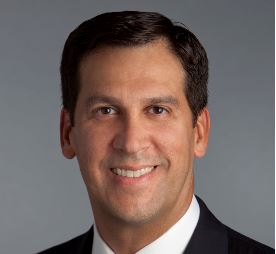You're starting to see this evolution of how government's looking, embracing this around a people-centric workplace. The workplace can be anywhere that individual may be, and they're putting in the policies and procedures to actually adapt to that.
Matt Mandrgoc
Head of U.S. Public Sector, Zoom
There's five things that really tie into how you would look for a successful communications, collaboration solution. Cloud based and its ease of use become the number one thing I've heard from every single customer. They can turn it on and they know how to use it, and they know it's secure and it's scalable. Now Zoom has these things where you can create a room and you can have different people sitting up, playing different types of immersive things to make this even feel more of a human-to-human interaction and human connection extensibility. This becomes important because in our commercial version, we have hundreds of integrations with different solutions. We are also working on a Zoom for Government platform to actually get the integration with other FedRAMP solutions. So think about the fact that not only we do this here, but can you if I have a FedRAMP version of an investment that has another solution I use, and I can integrate two solutions together. That's automating the process and making it easier for them.
Matt Mandrgoc
Head of U.S. Public Sector, Zoom
Many agencies always prided themselves as hubs of collaboration. The open office surge in the early 2010s. The use of things like industry days to bring vendors and federal buying officials together. These are but two examples of what agencies thought was impactful collaboration.
Then the COVID-19 pandemic struck, and we all entered a new culture norm when it came to collaboration and communication.
Agencies and companies quickly adapted to video communications for staff meetings, for industry days and for providing telehealth services. Without a doubt, the pandemic’s impact on the way agencies communicate internally and externally will be felt for decades.
The ease and comfort at which agencies moved to this new online-only approach was both surprising and a precursor for the future.
Agencies found employees were more satisfied and more productive, citizens found it easier, in some cases, to work with federal offices and security of the data and communications was as rigorous as in person events.
As agencies come out of the pandemic, they must figure out how to prosper in a hybrid world where communication and collaboration will be in person and online.
Matt Mandrgoc, the head of US public sector at Zoom, said the pandemic showed three things: Incumbent technologies were not necessarily scalable to satisfy the needs of the mass remote work environment; the culture change brought on by mass telework will be permanent; and cloud services were critical to all of these successes.
“You’re starting to see this evolution of how government’s looking, embracing this around a people-centric workplace,” Mandrgoc said on the Innovation in Government show sponsored by Carahsoft. “The workplace can be anywhere that individual may be, and they’re putting in the policies and procedures to actually adapt to that.”
That concept that work is what you do, not where you do it is a major piece to the culture change.
Mandrgoc said one agency customer found their employees were as productive or more productive working from home as they were in the office. At the same time, he said the agency also realized the remote working opened the door to recruit new employees from a wider area.
“This was a very special skill set that they needed. So instead of having to be in the DC metro area, maybe they would hire somebody from Raleigh, N.C., or from Austin, Texas, or from Denver or from California, all of those places out there. They have that skill set and they don’t have to be just in DC because you are providing them the productivity tools to actually do that,” he said. “We saw FEMA doing a lot of work out there in the field, using Zoom, to get the messaging out to actually work along with the different first responders to get information. We started to talk a lot about recruiting, just bringing employees in to the government.”
He said the military and civilian agencies embraced the technology, expanded recruiting and saw their numbers actually increase during the pandemic.
Agencies also took advantage of the cloud technology and the collaboration tools to reach citizens in a new and better way.
From telehealth to remote hearings to other ways, agencies could now engage citizens in a way that was less dependent on weather or staffing.
“We saw as not just the federal, the state, local governments also transitioning. We saw hearings and meetings that were occurring, and typically people would have to go in central location to watch a hearing. Now you saw a lot of these humans going into the remote status, and there was just a tremendous growth around that piece of it, which ties in citizens and talking to customers,” Mandrgoc said. “Some states are actually mandating that going forward because they were getting more people attending these types of meetings. It’s hard that if I have the hearing is at 5 p.m. on Wednesday, and kids have events or something happens and traffic is bad, I can’t get there. I can’t be participate in that. But I can click on, pop on my Zoom, go ahead and listen, watch what was going on. So they’re we’re seeing they’re getting more citizen engagement that way.”
Mandrgoc said all of these successes and experiences is leading to a hybrid workplace where in-person and online events, meetings and the like will be a standard and expected approach.
“There’s five things that really tie into how you would look for a successful communications, collaboration solution. Cloud based and its ease of use become the number one thing I’ve heard from every single customer. They can turn it on and they know how to use it, and they know it’s secure and it’s scalable,” Mandrgoc said. “Now Zoom has these things where you can create a room and you can have different people sitting up, playing different types of immersive things to make this even feel more of a human-to-human interaction and human connection extensibility. This becomes important because in our commercial version, we have hundreds of integrations with different solutions. We are also working on a Zoom for Government platform to actually get the integration with other FedRAMP solutions. So think about the fact that not only we do this here, but can you if I have a FedRAMP version of an investment that has another solution I use, and I can integrate two solutions together. That’s automating the process and making it easier for them.”
 About Zoom
About Zoom
Zoom is for you. We help you express ideas, connect to others, and build toward a future limited only by your imagination. Our frictionless communications platform is the only one that started with video as its foundation, and we have set the standard for innovation ever since. That is why we are an intuitive, scalable, and secure choice for large enterprises, small businesses, and individuals alike. Founded in 2011, Zoom is publicly traded (NASDAQ:ZM) and headquartered in San Jose, California. Visit zoom.com and follow @zoom.
Copyright
© 2024 Federal News Network. All rights reserved. This website is not intended for users located within the European Economic Area.










